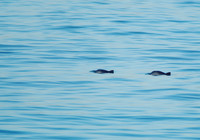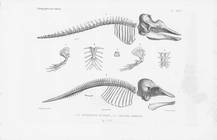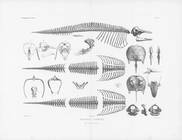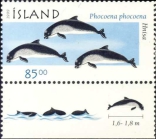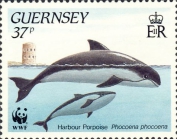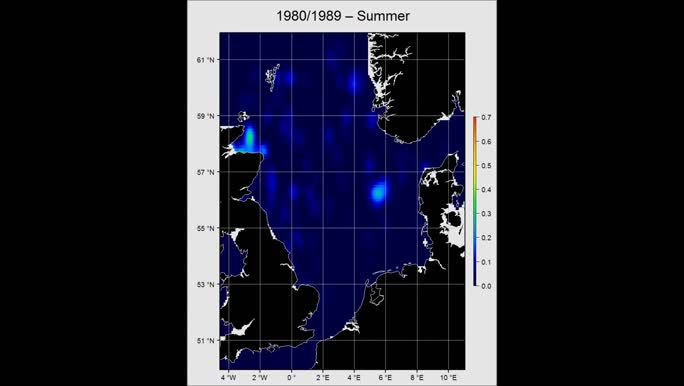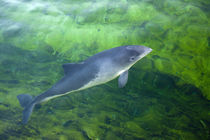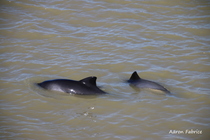WoRMS taxon details
Phocoena phocoena (Linnaeus, 1758)
137117 (urn:lsid:marinespecies.org:taxname:137117)
accepted
Species
Delphinus (Phocaena) phocaena Gray, 1828 · unaccepted (synonym)
Delphinus phocaena Muller, 1776 · unaccepted (synonym)
Delphinus phocoena Linnaeus, 1758 · unaccepted (basionym)
Delphinus ventricosus Lacépède, 1804 · unaccepted (synonym)
Phocaena americana J. A. Allen, 1869 · unaccepted (synonym)
Phocaena brachcium Hall & Kelson, 1959 · unaccepted (synonym)
Phocaena brachycium Cope, 1865 · unaccepted (synonym)
Phocaena communis Lesson, 1827 · unaccepted (synonym)
Phocaena lineata Cope, 1876 · unaccepted (synonym)
Phocaena phocaena Kleinenberg, 1956 · unaccepted (synonym)
Phocaena phocaena acuminata Van Deinse, 1935 · unaccepted (synonym)
Phocaena phocaena acuminata var. conidens Van Deinse, 1946 · unaccepted (synonym)
Phocaena tuberculifera Gray, 1865 · unaccepted (synonym)
Phocaena vomerina Gill, 1865 · unaccepted (synonym)
Phocena phocena Gray, 1821 · unaccepted (synonym)
Phocoena rondeletti Giglioli, 1870 · unaccepted (synonym)
Phocoena vomerina Hall & Kelson, 1959 · unaccepted (synonym)
- Subspecies Phocoena phocoena phocoena (Linnaeus, 1758)
- Subspecies Phocoena phocoena relicta Abel, 1905
- Subspecies Phocoena phocoena vomerina (Gill, 1865)
marine, brackish, terrestrial
(of Delphinus phocoena Linnaeus, 1758) Linnaeus, C. (1758). Systema Naturae per regna tria naturae, secundum classes, ordines, genera, species, cum characteribus, differentiis, synonymis, locis. <em>Editio decima, reformata [10th revised edition], vol. 1: 824 pp. Laurentius Salvius: Holmiae.</em> , available online at https://biodiversitylibrary.org/page/726886
page(s): 77 [details] Available for editors [request]
[request]
page(s): 77 [details] Available for editors
Note "Ocean Europaeo Balthico"
From editor or global species database
Type locality "Ocean Europaeo Balthico" [details]
Distribution East Pacific; Eastern Atlantic Ocean; Indo-West Pacific; Western Atlantic Ocean
Distribution East Pacific; Eastern Atlantic Ocean; Indo-West Pacific; Western Atlantic Ocean [details]
Fordyce, E.; Perrin, W.F. (2024). World Cetacea Database. Phocoena phocoena (Linnaeus, 1758). Accessed through: World Register of Marine Species at: https://www.marinespecies.org/aphia.php?p=taxdetails&id=137117 on 2024-11-21
Date
action
by
![]() The webpage text is licensed under a Creative Commons Attribution 4.0 License
The webpage text is licensed under a Creative Commons Attribution 4.0 License
original description
(of Delphinus phocoena Linnaeus, 1758) Linnaeus, C. (1758). Systema Naturae per regna tria naturae, secundum classes, ordines, genera, species, cum characteribus, differentiis, synonymis, locis. <em>Editio decima, reformata [10th revised edition], vol. 1: 824 pp. Laurentius Salvius: Holmiae.</em> , available online at https://biodiversitylibrary.org/page/726886
page(s): 77 [details] Available for editors [request]
[request]
context source (BeRMS 2020) Research Institute for Nature and Forest (INBO). European Seabirds at Sea - data collected by the Research Institute for Nature and Forest (INBO). INBO Seabird distribution data (all trips). [details]
basis of record van der Land, J. (2001). Tetrapoda, <B><I>in</I></B>: Costello, M.J. <i>et al.</i> (Ed.) (2001). <i>European register of marine species: a check-list of the marine species in Europe and a bibliography of guides to their identification. Collection Patrimoines Naturels,</i> 50: pp. 375-376 (look up in IMIS) [details]
additional source Carwardine, M., E. Hoyt, R. E. Fordyce and P. Gill. 1998. Whales, dolphins and porpoises. Time-Life Books. Nature Company Guides, USA. 288 p. [details]
additional source Muller, Y. (2004). Faune et flore du littoral du Nord, du Pas-de-Calais et de la Belgique: inventaire. [Coastal fauna and flora of the Nord, Pas-de-Calais and Belgium: inventory]. <em>Commission Régionale de Biologie Région Nord Pas-de-Calais: France.</em> 307 pp., available online at http://www.vliz.be/imisdocs/publications/145561.pdf [details]
additional source Mead, J. G.; Brownell, R. L. Jr. (2005). Cetacea. <em>In Wilson, D.E. & D.M. Reeder (eds). Mammal Species of the World. A Taxonomic and Geographic Reference (3rd ed), Johns Hopkins University Press, 2,142 pp.</em> 723--743., available online at http://www.bucknell.edu/msw3/ [details]
additional source Rice, D. W. (1998). Marine mammals of the world. Systematics and distribution. <em>Society for Marine Mammalogy Special Publication.</em> 4., available online at http://www.marinemammalscience.org/wp-content/uploads/2014/09/MarineMammalsOfTheWorld.pdf [details]
additional source Hershkovitz, P. (1966). Catalog of Living Whales. <em>Bulletin of the United States National Museum.</em> (246): 1-259., available online at https://doi.org/10.5479/si.03629236.246 [details]
additional source Jefferson, T. A., M. A. Webber and R. L. Pitman. (2008). Marine mammals of the world. Academic Press, Amsterdam. [details]
additional source IUCN Red List of Threatened Species, available online at http://www.iucnredlist.org [details]
additional source Perrin, W.F.; Würsig, B.; Thewissen, J.G.M. (2009). Encyclopedia of marine mammals. Second edition. Academic Press: London. ISBN 978-0-12-373553-9. xxix, 1316 pp. (look up in IMIS) [details]
additional source Gaskin, D. E., P. E. Arnold and B. A. Blair. (1974). Phocoena phocoena. Mammalian Species 42:1--8. [details]
additional source Integrated Taxonomic Information System (ITIS). , available online at http://www.itis.gov [details]
ecology source Looby, A.; Erbe, C.; Bravo, S.; Cox, K.; Davies, H. L.; Di Iorio, L.; Jézéquel, Y.; Juanes, F.; Martin, C. W.; Mooney, T. A.; Radford, C.; Reynolds, L. K.; Rice, A. N.; Riera, A.; Rountree, R.; Spriel, B.; Stanley, J.; Vela, S.; Parsons, M. J. G. (2023). Global inventory of species categorized by known underwater sonifery. <em>Scientific Data.</em> 10(1). (look up in IMIS), available online at https://doi.org/10.1038/s41597-023-02745-4 [details]
page(s): 77 [details] Available for editors
context source (BeRMS 2020) Research Institute for Nature and Forest (INBO). European Seabirds at Sea - data collected by the Research Institute for Nature and Forest (INBO). INBO Seabird distribution data (all trips). [details]
basis of record van der Land, J. (2001). Tetrapoda, <B><I>in</I></B>: Costello, M.J. <i>et al.</i> (Ed.) (2001). <i>European register of marine species: a check-list of the marine species in Europe and a bibliography of guides to their identification. Collection Patrimoines Naturels,</i> 50: pp. 375-376 (look up in IMIS) [details]
additional source Carwardine, M., E. Hoyt, R. E. Fordyce and P. Gill. 1998. Whales, dolphins and porpoises. Time-Life Books. Nature Company Guides, USA. 288 p. [details]
additional source Muller, Y. (2004). Faune et flore du littoral du Nord, du Pas-de-Calais et de la Belgique: inventaire. [Coastal fauna and flora of the Nord, Pas-de-Calais and Belgium: inventory]. <em>Commission Régionale de Biologie Région Nord Pas-de-Calais: France.</em> 307 pp., available online at http://www.vliz.be/imisdocs/publications/145561.pdf [details]
additional source Mead, J. G.; Brownell, R. L. Jr. (2005). Cetacea. <em>In Wilson, D.E. & D.M. Reeder (eds). Mammal Species of the World. A Taxonomic and Geographic Reference (3rd ed), Johns Hopkins University Press, 2,142 pp.</em> 723--743., available online at http://www.bucknell.edu/msw3/ [details]
additional source Rice, D. W. (1998). Marine mammals of the world. Systematics and distribution. <em>Society for Marine Mammalogy Special Publication.</em> 4., available online at http://www.marinemammalscience.org/wp-content/uploads/2014/09/MarineMammalsOfTheWorld.pdf [details]
additional source Hershkovitz, P. (1966). Catalog of Living Whales. <em>Bulletin of the United States National Museum.</em> (246): 1-259., available online at https://doi.org/10.5479/si.03629236.246 [details]
additional source Jefferson, T. A., M. A. Webber and R. L. Pitman. (2008). Marine mammals of the world. Academic Press, Amsterdam. [details]
additional source IUCN Red List of Threatened Species, available online at http://www.iucnredlist.org [details]
additional source Perrin, W.F.; Würsig, B.; Thewissen, J.G.M. (2009). Encyclopedia of marine mammals. Second edition. Academic Press: London. ISBN 978-0-12-373553-9. xxix, 1316 pp. (look up in IMIS) [details]
additional source Gaskin, D. E., P. E. Arnold and B. A. Blair. (1974). Phocoena phocoena. Mammalian Species 42:1--8. [details]
additional source Integrated Taxonomic Information System (ITIS). , available online at http://www.itis.gov [details]
ecology source Looby, A.; Erbe, C.; Bravo, S.; Cox, K.; Davies, H. L.; Di Iorio, L.; Jézéquel, Y.; Juanes, F.; Martin, C. W.; Mooney, T. A.; Radford, C.; Reynolds, L. K.; Rice, A. N.; Riera, A.; Rountree, R.; Spriel, B.; Stanley, J.; Vela, S.; Parsons, M. J. G. (2023). Global inventory of species categorized by known underwater sonifery. <em>Scientific Data.</em> 10(1). (look up in IMIS), available online at https://doi.org/10.1038/s41597-023-02745-4 [details]
 Present
Present  Present in aphia/obis/gbif/idigbio
Present in aphia/obis/gbif/idigbio  Inaccurate
Inaccurate  Introduced: alien
Introduced: alien  Containing type locality
Containing type locality
From editor or global species database
Biology Harbour porpoises live either solitarily or in groups, normally of three to five individuals, although sometimes more. Normally individual porpoises or couples (mother and calf) are observed and high numbers can be seen during migrations.Like dolphins, the harbour porpoise orientates itself by means of echo-sounding or ‘sonar’. It has a particular way of swimming with a ‘rolling’ movement (imagine a turning wheel); part of the back, including the dorsal fin surfaces briefly before re-entering the water giving the appearance of a rotating motion. This movement will normally be repeated three to four times, prior to a long dive.
The diet of an adult harbour porpoise is made up of various pelagic and demersal fish, as well as invertebrates. In the Southern North Sea, it consists mainly of small benthic fish, herring, cephalopod, whiting and cod. A daily meal would normally consist of about 5 kilos fish (around 10% of the body [details]
Diet Variety of inshore and offshore fish, herring, mackerel, and anchovy. Krill when young. [details]
Holotype None in existence; name based on common porpoise of authors. [details]
IUCN Red List Category Least Concern (LC) [details]
IUCN Red List Category Subpopulation Baltic Sea harbour porpoise : Critically Endangered (CR) [details]
Morphology Distinguishing characteristics: Dives without lifting tail. Blow not readily visible. Triangular dorsal fin. Spoon-shaped teeth. Blunt snout. Colour is grey above with white belly. [details]
Morphology The head is blunt. Depending on the light, the back may appear black, grey or brown). The flanks are grey and the underside is white. The pectoral fins are black. A dark line runs from the corner of the mouth to the flipper. The more or less triangular small dorsal fin is positioned in the centre of the back. The upper back and dorsal fin are the only features one normally gets to see of a swimming harbour porpoise. The chief characteristics are its small size, the blunt head and the small triangular dorsal fin. [details]
Reproduction Calving: May to June in the North Atlantic. Weaning at six months. [details]
Type locality "Ocean Europaeo Balthico" [details]
Unreviewed
Dimensions Length: male 6' (1.9 m), female 6' (1.9 m), at birth 2 1/2' (0.7 m) [details]Distribution East Pacific; Eastern Atlantic Ocean; Indo-West Pacific; Western Atlantic Ocean [details]
Habitat inshore and offshore [details]
Habitat cool temperate and subpolar, mostly in shallow water [details]
Predators None [details]
| Language | Name | |
|---|---|---|
| Aleut | alagikkhaladak | [details] |
| Basque | izurdia | [details] |
| Bulgarian | Муткурmutkur | [details] |
| Catalan | marsopa comuna | [details] |
| Czech | svinucha pobrezní | [details] |
| Danish | tumlermarsvin | [details] |
| Dutch | zee-varktonynbruinvischbruinvis | [details] |
| English | sea-pigsea-hogpuffy-dunterpuffing pigporpesspellocknisack (Shetlands)neesockhogfishherring hogharbour porpoiseharbor porpoisecommon porpoisebuckerbay porpoise | [details] |
| Faroese | nise | [details] |
| French | poursillephocene marsouinmarsouin communmarsouin | [details] |
| German | SchweinswalMeerschweinkleiner TummlerBraunfisch | [details] |
| Icelandic | hnisahandfiskarbruinskop | [details] |
| Irish | muc mhara | [details] |
| Italian | marsuinofocena | [details] |
| Japanese | ネズミイルカnezumi iruka | [details] |
| Kalaallisut | piglertok | [details] |
| Korean | soe-dolgorae | [details] |
| Latin | maris sus | [details] |
| Latvian | jurascuka | [details] |
| Lithuanian | paprastoji jūrų kiaulė | [details] |
| Modern Greek (1453-) | Φώκαινα | [details] |
| Norwegian | tumlernisenesa, nise or nisamarsvün | [details] |
| Norwegian Bokmål | nise | [details] |
| Norwegian Nynorsk | nise | [details] |
| Polish | swinia morskamorświn zwyczajnymorświn (zwyczajny)morświn | [details] |
| Portuguese | toninhaboto | [details] |
| Romanian | focena | [details] |
| Russian | svinkashutniksapunpyktunmorskaya svinyachuskaburtukazovskii delfin (Azov Sea)azovskii delfinazovka (Black and Azov Seas)azovka | [details] |
| Scottish Gaelic | pellock | [details] |
| Slovenian | pristaniška rjava pliskavka | [details] |
| Spanish | puerco de marmarsopa de portenamarsopa de bahiamarsopa comúnmarsopa | [details] |
| Swedish | tumlaretrumblarenisemarsvin | [details] |
| Turkish | yunusmuturbayağı musur (balina)bayağı musur | [details] |
| Ukrainian | Фоцена звичайнаМорська свиня | [details] |
| Welsh | llamhidydd | [details] |
Marine Life Information Network - UK
To Barcode of Life (57 barcodes)
To Biodiversity Heritage Library (113 publications) (from synonym Phocaena phocaena Kleinenberg, 1956)
To Biodiversity Heritage Library (12 publications) (from synonym Phocaena lineata Cope, 1876)
To Biodiversity Heritage Library (15 publications) (from synonym Phocaena brachycium Cope, 1865)
To Biodiversity Heritage Library (2 publications) (from synonym Phocaena phocaena acuminata Van Deinse, 1935)
To Biodiversity Heritage Library (201 publications) (from synonym Delphinus phocaena Muller, 1776)
To Biodiversity Heritage Library (21 publications) (from synonym Phocaena vomerina Gill, 1865)
To Biodiversity Heritage Library (22 publications) (from synonym Phocoena vomerina Hall & Kelson, 1959)
To Biodiversity Heritage Library (23 publications) (from synonym Delphinus ventricosus Lacépède, 1804)
To Biodiversity Heritage Library (25 publications) (from synonym Phocaena tuberculifera Gray, 1865)
To Biodiversity Heritage Library (38 publications) (from synonym Delphinus phocoena Linnaeus, 1758)
To Biodiversity Heritage Library (396 publications) (from synonym Phocaena communis Lesson, 1827)
To Biodiversity Heritage Library (85 publications)
To Biodiversity Heritage Library (9 publications) (from synonym Phocena phocena Gray, 1821)
To Biological Information System for Marine Life (BISMaL)
To Dyntaxa
To European Nucleotide Archive, ENA (Phocoena phocoena)
To GenBank (22513 nucleotides; 954 proteins) (from synonym Delphinus phocoena Linnaeus, 1758)
To GenBank (22513 nucleotides; 954 proteins)
To Global Biotic Interactions (GloBI)
To IUCN Red List (Least Concern)
To NMNH Extant Collection (Hal and Bee (1954). Occurrence of the harbor porpoise at Point Barrow, Alaska.)
To NMNH Extant Collection (Phocæna, or, The anatomy of a porpess, dissected at Gresham Col)
To PESI
To ITIS
To Barcode of Life (57 barcodes)
To Biodiversity Heritage Library (113 publications) (from synonym Phocaena phocaena Kleinenberg, 1956)
To Biodiversity Heritage Library (12 publications) (from synonym Phocaena lineata Cope, 1876)
To Biodiversity Heritage Library (15 publications) (from synonym Phocaena brachycium Cope, 1865)
To Biodiversity Heritage Library (2 publications) (from synonym Phocaena phocaena acuminata Van Deinse, 1935)
To Biodiversity Heritage Library (201 publications) (from synonym Delphinus phocaena Muller, 1776)
To Biodiversity Heritage Library (21 publications) (from synonym Phocaena vomerina Gill, 1865)
To Biodiversity Heritage Library (22 publications) (from synonym Phocoena vomerina Hall & Kelson, 1959)
To Biodiversity Heritage Library (23 publications) (from synonym Delphinus ventricosus Lacépède, 1804)
To Biodiversity Heritage Library (25 publications) (from synonym Phocaena tuberculifera Gray, 1865)
To Biodiversity Heritage Library (38 publications) (from synonym Delphinus phocoena Linnaeus, 1758)
To Biodiversity Heritage Library (396 publications) (from synonym Phocaena communis Lesson, 1827)
To Biodiversity Heritage Library (85 publications)
To Biodiversity Heritage Library (9 publications) (from synonym Phocena phocena Gray, 1821)
To Biological Information System for Marine Life (BISMaL)
To Dyntaxa
To European Nucleotide Archive, ENA (Phocoena phocoena)
To GenBank (22513 nucleotides; 954 proteins) (from synonym Delphinus phocoena Linnaeus, 1758)
To GenBank (22513 nucleotides; 954 proteins)
To Global Biotic Interactions (GloBI)
To IUCN Red List (Least Concern)
To NMNH Extant Collection (Hal and Bee (1954). Occurrence of the harbor porpoise at Point Barrow, Alaska.)
To NMNH Extant Collection (Phocæna, or, The anatomy of a porpess, dissected at Gresham Col)
To PESI
To ITIS


